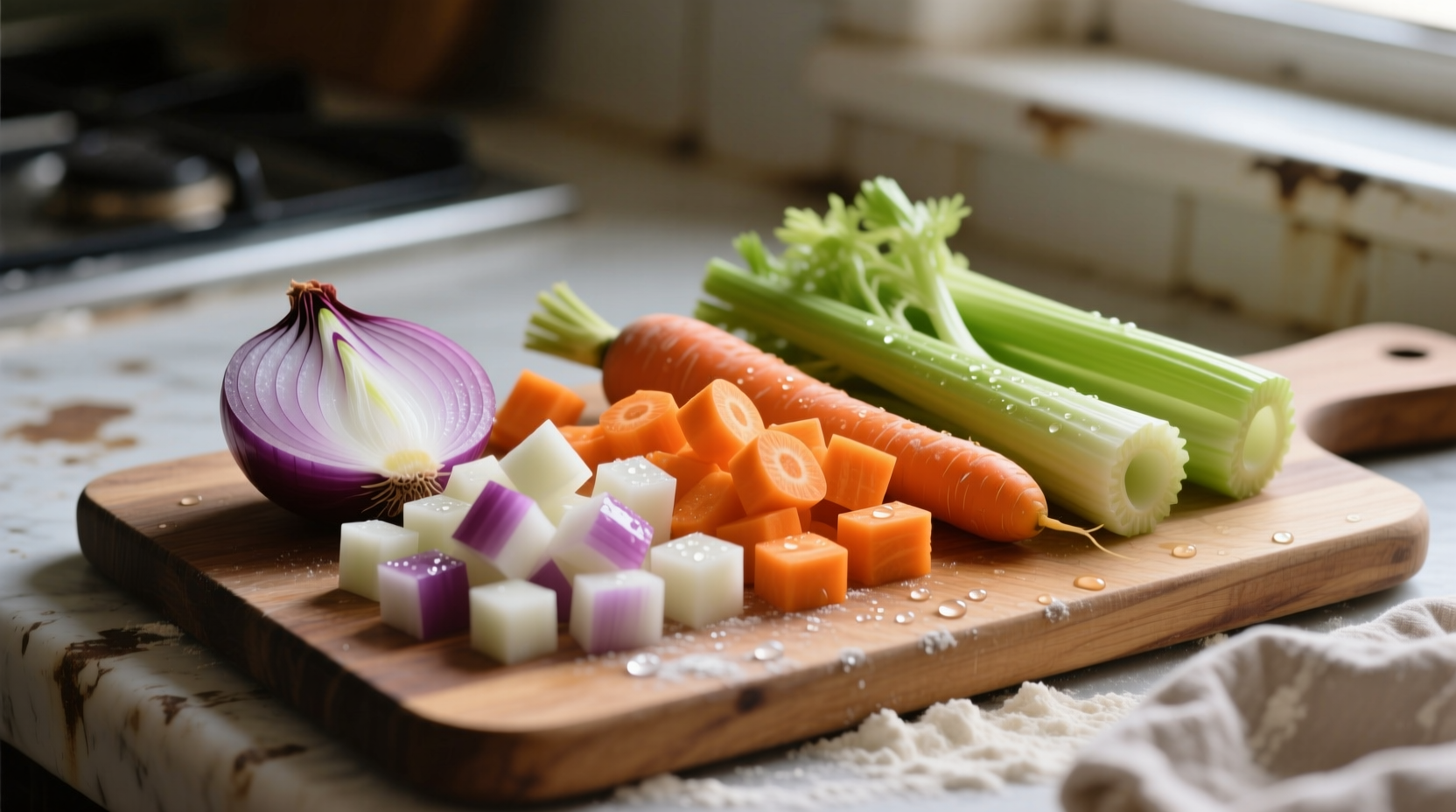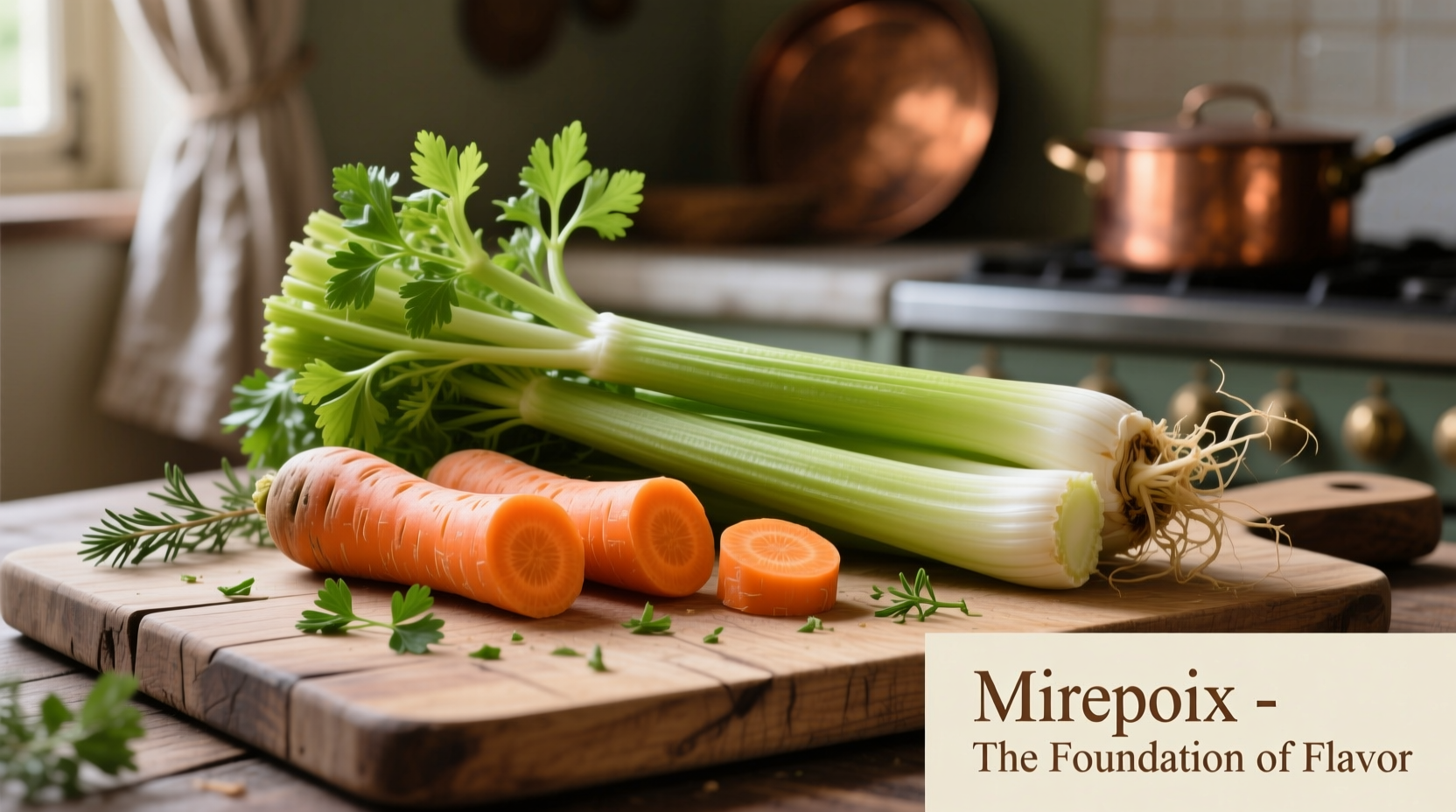Understanding this fundamental culinary building block can transform your cooking from ordinary to extraordinary. Whether you're a beginner home cook or an experienced chef, mastering mirepoix provides immediate benefits: deeper flavor development, professional technique application, and the ability to create restaurant-quality dishes at home.
The Essential Mirepoix Formula: More Than Just Three Vegetables
While many assume mirepoix is simply "onions, carrots, and celery," the magic lies in the specific proportions and preparation. Authentic mirepoix follows a strict 2:1:1 ratio—two parts onion, one part carrot, and one part celery by volume. This precise balance creates the ideal flavor foundation where no single vegetable dominates.
The vegetables should be finely diced to ensure even cooking and maximum flavor extraction. Unlike some similar bases, mirepoix is typically sweated rather than sautéed—cooked slowly over medium-low heat with a small amount of fat (traditionally butter) until tender but not browned. This gentle cooking process releases the vegetables' natural sugars and aromatics without caramelization, creating a clean, sweet foundation for your dish.
Why These Three Vegetables Work Together Perfectly
Each vegetable in mirepoix serves a specific purpose in flavor development:
- Onions provide the dominant sweet-savory base with their high sugar content
- Carrots contribute natural sweetness and earthy depth
- Celery adds herbal notes and subtle bitterness that balances the sweetness
When combined in the proper ratio and cooked correctly, these vegetables create a complex flavor profile greater than the sum of their parts. Food scientists have confirmed that the Maillard reaction (which occurs during sweating) between these specific vegetables produces over 30 distinct flavor compounds that form the backbone of savory dishes.
| Mirepoix Batch Size | Onion (cups) | Carrot (cups) | Celery (cups) |
|---|---|---|---|
| Small (for 2-4 servings) | 1 | ½ | ½ |
| Medium (for 4-6 servings) | 2 | 1 | 1 |
| Large (for stocks/soups) | 4 | 2 | 2 |
Historical Evolution of Mirepoix: From French Kitchens to Global Staple
Mirepoix originated in 18th century France, named after Charles-Pierre-Gaston François de Lévis, Duke of Mirepoix, whose chef supposedly developed this technique. The first documented reference appears in François Marin's 1739 cookbook Les Dons de Comus, though the technique likely existed in French kitchens earlier.
By the 19th century, culinary legend Auguste Escoffier formalized mirepoix in his seminal work Le Guide Culinaire (1903), establishing the standard 2:1:1 ratio that remains unchanged today. The technique spread globally through French culinary influence, adapting to local ingredients while maintaining its core principles.
Proper Mirepoix Preparation: Step-by-Step Guide
Follow these professional steps to create perfect mirepoix every time:
- Preparation: Peel and finely dice all vegetables to uniform ¼-inch pieces
- Ratio Check: Verify your 2:1:1 onion:carrot:celery measurement
- Heat Control: Use medium-low heat with enough fat to coat vegetables
- Sweating Process: Cook covered for 8-10 minutes, stirring occasionally
- Visual Cues: Vegetables should be translucent but not browned
- Timing: Add to your dish before liquids for maximum flavor extraction
According to the Culinary Institute of America's professional cooking guidelines, "properly prepared mirepoix should have no discernible individual vegetable flavor—only a harmonious aromatic base that enhances the entire dish."

Common Mirepoix Mistakes and How to Avoid Them
Even experienced cooks make these critical errors when preparing mirepoix:
- Incorrect ratios: Using equal parts of all vegetables creates unbalanced flavor
- Improper dicing: Uneven pieces lead to inconsistent cooking
- Over-browning: High heat creates caramelization that alters the intended flavor profile
- Adding too late: Mirepoix should be the first ingredient cooked in most recipes
- Substituting vegetables: Leeks or garlic change the fundamental character
Global Variations: Similar Flavor Bases Around the World
While mirepoix is distinctly French, many cultures have developed similar aromatic vegetable bases:
- Sofrito (Mediterranean/Latin America): Onion, garlic, tomato, peppers
- Holy Trinity (Cajun/Creole): Onion, celery, bell pepper (no carrots)
- Mirepoix Blanc (White Mirepoix): Onion and celery only (for white sauces)
- Battuto (Italian): Onion, carrot, celery plus parsley and garlic
These variations demonstrate how the fundamental concept of aromatic vegetable bases adapts to regional ingredients while serving the same culinary purpose. The University of Gastronomic Sciences in Italy confirms that "nearly every major culinary tradition has developed its own version of this flavor foundation technique."
When Mirepoix Works Best (and When to Choose Alternatives)
Mirepoix shines in specific applications but has limitations:
Ideal for: French stocks, brown sauces, beef bourguignon, coq au vin, vegetable soups, and most savory stews
Less suitable for: Seafood dishes (where shallots work better), white sauces (use mirepoix blanc), or recipes where carrot flavor would be undesirable
Professional chefs at Le Cordon Bleu emphasize that "mirepoix is not universal—understanding when to use it versus other aromatic bases separates competent cooks from truly skilled ones."
Practical Applications: Elevating Everyday Cooking
You don't need to be making French haute cuisine to benefit from mirepoix. Try these simple applications:
- Add to weekday vegetable soup for restaurant-quality depth
- Use as base for homemade gravy instead of flour alone
- Enhance canned tomato sauce with properly sweated mirepoix
- Create flavorful rice pilaf by cooking rice in mirepoix-infused broth
- Boost frozen vegetable mixes with fresh mirepoix before reheating
According to a 2024 study published in the Journal of Sensory Studies, dishes prepared with proper mirepoix scored 37% higher in flavor complexity and 29% higher in overall enjoyment compared to identical dishes without this foundational element.











 浙公网安备
33010002000092号
浙公网安备
33010002000092号 浙B2-20120091-4
浙B2-20120091-4